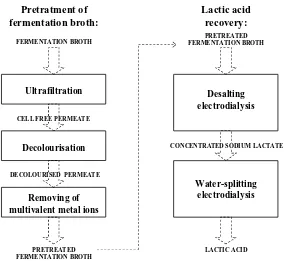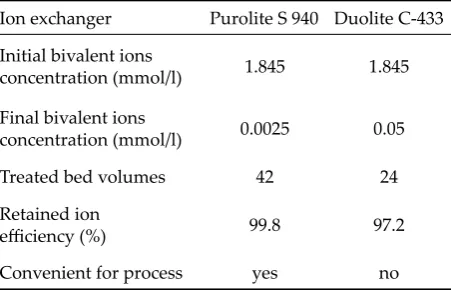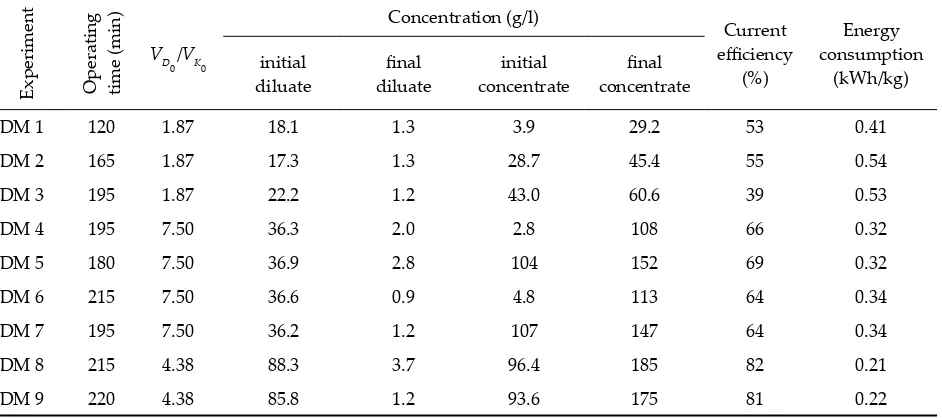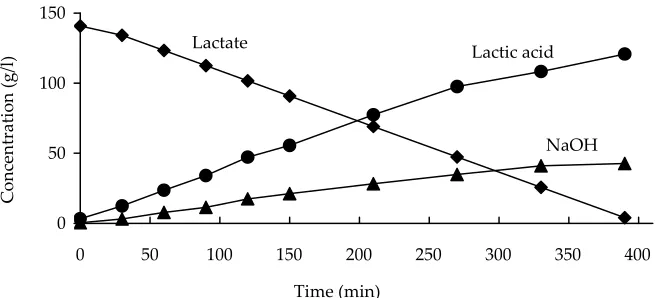87 Lactic acid (2-hydroxypropionic acid) was
discovered for the first time in 1780 by a Swed-ish chemist Scheele and since 1881 it has been produced commercially by fermentation. Lactic acid is frequently used in food industry, esp. for the beverage production and in pharmaceutical industry, chemical industry, or medicine (V��� R�� 1985). The recent growing interest for the manufacture of biodegradable plastics initiates a high demand for lactic acid as the raw mate-rial for polylactate production (D���� et al. 1995; S�������� & S���� 2002).
Another very promising lactic acid application is the production of environmentally friendly “green” solvents (lactate esters). They can replace traditional solvents made from petrochemical feedstocks (T��� et al. 1999).
Generally, lactic acid can by manufactured by either biological fermentation or chemical synthesis. While the chemical synthesis pro-duces a racemic mixture of lactic acid (�(+)- and �(–)-forms), fermentation technology is able to selectively synthesise the desired enantiomer due to the high stereospecifity of several lactic acid bacteria. The traditional fermentation process is carried out in the batch mode at a constant pH between 5.5 and 6.0 and at temperatures above 40°C, with molasses or other sugars as the C-source (K����� et al. 1996).
There are a lot of studies on lactic acid fermen-tation, on the production of �(+) lactic acid, and on the use of the agricultural cellulosic feedstock and waste for this purpose (I��� & L�� 1999; B�� et al. 2003a,b; J�� et al. 2003; W������ et al. 2003).
Supported from EUREKA ∑! 1820 BIOLACTATE and by the Ministry of Education, Youth and Sports of the Czech Republic, Grant No. CEZ: J19/98: 223300005.
Modern Method of Lactic Acid Recovery
from Fermentation Broth
V��� HÁBOVÁ, K���� MELZOCH and M����� RYCHTERA
Department of Fermentation Chemistry and Bioengineering, Institute of Chemical Technology in Prague, Prague, Czech Republic
Abstract
H����� V., M������ K., R������� M. (2004): Modern method of lactic acid recovery from fermentation broth. Czech J. Food Sci., 22: 87–94.
Electrodialysis was used for lactic acid recovery from fermentation broth. In the first step, lactate was recovered and concentrated by desalting electrodialysis, and the second step was electroconversion of lactate to lactic acid by water-splitting electrodialysis. The final lactic acid concentration of 151 g/l was obtained. Total energy required in both electrodialysis processes was about 1.5 kWh per 1 kg of lactic acid obtained. The fermentation broth had to be pretreated prior to the electrodialysis experiments. The pretreatment consisted of ultrafiltration, decolouri-sation, and the removal of multivalent metal ions.
88 89 To obtain lactic acid of the required purity, efficient
downstream processing is necessary. The conven-tional fermentation process produces calcium lactate precipitate which has to be reacidified with a strong acid; large amounts of effluents arise, in particular gypsum. It was estimated that downstream processes absorb about 80% of the production costs, indicating an urgent need for more economical downstream technologies, and for bioengineers to design and operate them (H���� 2004).
Recently, many investigations were focused on the downstream processing of lactic acid from fermentation broth with the aim to reduce costs, to simplify the recovery procedure, to reduce the contents of effluents, and to decrease the negative impact on the surrounding environment (T����� et al. 1994; M�������� et al. 1998; F������� & S������� 1999; C�� et al. 2002).
Membrane techniques, mainly electrodialysis and nanofiltration, have been shown as promis-ing ways for the lactic acid recovery (J������ et al. 1996; B����� 2002; C��� et al. 2002). L�� et al. (1998) used a two-stage electrodialysis method for the lactic acid recovery and K�� and M��� (2001) used one-stage electrodialysis with two- and three-compartment water-splitting electrodialysis. L� et al. (2004) proposed an electrokinetic membrane bioreactor for the lactic acid production that couples fermentation with in situ lactic acid separation and the product concentration. B�������� et al. (1998) studied an integrated process using electrodialysis for the lactic acid recovery. M��-T��� et al. (2003) described the production of �(+) lactic acid by the electrodialysis fermentation.
MATERIAL AND METHODS
Chemicals. Sodium lactate (p. a. purity) was from Sigma, the other chemicals were chemi-cally pure products of Lachema (Brno, Czech Republic). Demineralised water (resistivity of 18.2 MΩ.cm) was prepared from distilled water in the device Millipore – Q gradient (Molsheim, France). Granulated active charcoal Purolite AC 20G (Purolite International Ltd., UK) was used for decolourisation of the fermentation broth. Chelat-ing resin Purolite S 940 (Purolite International Ltd., UK) and the weak cation exchanger Duolite C-433 (Fluka, Switzerland) were used for the recovery of multivalent metal ions.
Fermentation broth. Real fermentation broth was obtained through lactic acid fermentation using
Lactobacillus plantarum L10 as the producent strain (the strain was obtained from the Collection of Department of Dairy and Fat Technologies, ICT Prague, Czech Republic). The lactate concentra-tion ranged from 17 to 88 g/l. The initial medium consisted, respectively, of (g/l): glucose, 40–100; yeast extract, 5.3; KH2PO4, 2.6; CH3COONa.3H2O, 6.6; ammonium citrate 2.6; MgSO4.7H2O, 0.24; MnSO4.4H2O. The fermentation temperature was 37°C and pH was kept at 5.8 by means of NaOH (20 g/l).
Electrodialysis equipment. The electrodialysis laboratory unit BEL-500 (Berghof, Germany) consisted of a control unit (adjustable outputs of voltage from 0 to 50 V and of current from 0 to 3.9 A), a measuring device (conductivity and volt-age), and 3 independent circuits with pumps and storage containers (for the diluate, the concentrate, and the electrode solution). The membrane stack ED 0 (Mega, Czech Republic) with 20 pairs of ion exchange membranes Ralex CMH and Ralex AMH was used for the desalting in the electrodialysis experiments. The effective membrane area was 180 cm2, the distance between the membranes was 1 mm. Stack Type 500 with 4 bipolar membranes Neosepta BP-1 and 5 cation exchange membranes Neosepta CMB (Tokuyama Corp., Japan) was used for water-splitting electrodialysis, the distance between membranes being 0.5 mm. The effective membrane area was 57.6 cm2.
Operating conditions. Electrodialysis experi-ments were carried out in the batch mode.
Desalting electrodialysis: The electrode solution (Na2SO4 – 25 g/l), the concentrate (sodium lactate – initial concentration 3–104 g/l), and the diluate (the pretreated fermentation broth – the initial concentration from 15 to 88 g/l) were circulated through the corresponding compartments of the desalting stackat the flow rate of 2.4 l/min. For the constant current period, voltage of 1.5 V per one pair and current density of 7.8 mA/cm2 were used. For the constant voltage period, voltage of 18 V was used. The experiments were terminated when the lactate concentration in the diluate dropped to 1–2 g/l.
In the case of the two-level electrodialysis, only the depleted diluate was replaced by another fresh fermentation broth after the first level. The conditions of the second level were the same as mentioned above.
88 89 solution), NaOH – 1 g/l (concentrate), and the
concentrate obtained from desalting electrodi-alysis (diluate). Current density of 67.7 mA/cm2 and voltage of 12 V were applied. The circulation flow rate was 2 l/min. When conductivity in the diluate reached the value of 5 mS/cm, the experi-ments were terminated.
Ultrafiltration. UF cartridge TFF 300 kD (Mil-lipore, USA) was used for the clarification of the fermented broth.
Decolourisation, the removal of multivalent metal ions. These operations were carried out in glass columns filled with the above mentioned ma-terials. The flow rate of the cell-free fermentation broth through the column was 1 bed volume per hour (decolourisation), resp. 2 bed volumes per hour (removing of multivalent metal ions).
Analytical methods. Lactate was determined by HPLC (Laboratorní přístroje Praha, Czech Republic); column – Ostion LG KS in H-cycle; refractometer detector RIDK 101; mobile phase – H2SO4 (c = 0.005 mol/l), flow rate of the mobile phase 0.5 ml/min; column temperature 85°C. The concentration of lactic acid and the concentration of NaOH were determined by titration with stand-ard solutions of NaOH (c = 0.025 mol/l) or HCl (c = 1 mol/l), respectively, using phenolphthalein as indicator. The colour intensity of the fermentation broth was measured by spectrophotometer at the wavelength of 400 nm relative to water. Multivalent
metal ions were determined by AAS method, and the biomass as a dry weight at 105°C.
Calculations. The equations were taken from L�� et al. (1998).
RESULTS AND DISCUSSION
[image:3.595.65.350.493.754.2]A sequence of five separative steps for the lactic acid recovery from the fermentation broth was proposed and tested. The separation consisted of three pre-treating steps (ultrafiltration, decolouri-sation, the removal of multivalent metal ions), and of two electrodialysis procedures (desalting electrodialysis and water-splitting electrodialysis) (Figure 1).
Pretreatment of fermentation broth
The fermentation broth had to be pretreated prior to the electrodialysis experiment due to the high demands of the electrodialysis membranes, especially bipolar ones, on the quality of the feed solution used. The cells can be deposited on the membrane surface and create clusters in the space between the membranes, the dyes from the fermen-tation broth can be adsorbed on the membranes. Both phenomena significantly decrease the elec-trodialysis efficiency (C����� et al. 1987; H������ et al. 1993). Multivalent metal ions (Ca, Mg, Fe, etc.) cause irreversible damage of the bipolar
Desalting electrodialysis
Water-splitting electrodialysis Ultrafiltration
Decolourisation
Removing of multivalent metal ions
Pretratment of fermentation broth:
Lactic acid recovery:
FERMENTATION BROTH FERMENTATION BROTHPRETREATED
LACTIC ACID PRETREATED
FERMENTATION BROTH CELL FREE PERMEATE
DECOLOURISED PERMEATE
CONCENTRATED SODIUM LACTATE
90 91 membranes, they require, consequently, less than
1 mg multivalent metal ions per litre.
Ultrafiltration
The broth after lactic acid fermentation contained 3.35 g/l of biomass, the cells having been removed from it by a spiral-wound module. The cell free permeate and concentrate containing 51.1 g/l of biomass were obtained. Relatively considerable fouling of membranes was found. To use a differ-ent type of the membrane cartridge would seem advisable.
Decolourisation
The renewable granulated active charcoal Purolite AC 20 was chosen and used for decolourisation. The results were reported earlier (H����� et al. 2001).
The flow of the fermentation broth through the column influenced significantly the decolourisa-tion degree. If the flow rate was as slow as 1 bed volume per hour only, the amount of the fermenta-tion broth corresponding to the 10-fold bed volume was decolourised by 90%. At a higher flow rate, the decolourisation capacity decreased. When the decolourisation was carried out in a batch mode, the decolourisation degree was equal to that men-tioned above; more decolourising agent, however, was used up.
Regeneration was done successively by water flow, by boiling with 4% HCl, by water flow, by boiling with 4% HCl and by water flow. Regenerated charcoal showed practically the same decolourisa-tion capacity as the initial batch and its value after 15 decolourising cycles was lower by 5%.
Removal of multivalent metal ions
Two ion exchangers were tested. The chelating resin Purolite AC 20 G showed better results than the weak cation exchanger Duolite C-433 (Table 1). Purolite AC 20 G was used for the removal of mul-tivalent metal ions from the fermentation broth designated for the electrodialysis experiments.
The compositions of the initial fermentation broth and of that treated with resin are given in Table 2. Depleted broth contained less than 1 mg/l of multivalent metals and the bipolar membrane could be used without risk of irreversible mem-brane damage.
Electrodialysis
Two-stage electrodialysis method was used for lactic acid recovery. Sodium lactate was removed from the pretreated fermentation broth and was concentrated by desalting electrodialysis. Further it was converted to lactic acid by water-splitting electrodialysis using bipolar membranes. Lactic acid was recovered from the model solutions and from the pretreated fermentation broth. The ex-periments with model solutions were focused on the determination of suitable conditions for the electrodialysis experiments and on the investiga-tion of the time course under different condiinvestiga-tions. The results obtained with model solutions were published earlier (H����� et al. 2001, 2004).
Desalting electrodialysis
[image:4.595.305.531.115.260.2]For desalting electrodialysis the fermentation broth was used with three different levels of lactate concentration: 18, 36, and 87 g/l. The results of the
Table 2. Composition of initial and treated fermentation broth (mg/l)
Ca Mg Fe Mn Zn Na K
Initial fermentation broth 28.3 38.8 0.64 4.36 0.44 16 500 935 Treated fermentation broth 0.39 0.47 0.04 0.02 0.02 16 800 868
Table 1. Comparison of resins used for removal of mul-tivalent metal ions (flow rate was 2 bed volumes/h)
Ion exchanger Purolite S 940 Duolite C-433 Initial bivalent ions
concentration (mmol/l) 1.845 1.845
Final bivalent ions
concentration (mmol/l) 0.0025 0.05
Treated bed volumes 42 24
Retained ion
efficiency (%) 99.8 97.2
[image:4.595.64.531.704.756.2]90 91 desalting electrodialysis experiments are shown in
Table 3. The highest lactate concentration reached was 185 g/l. The comparison of the lactate recovery from the model solutions and from the fermenta-tion broth showed that, in the case of fermentafermenta-tion broth with lower initial lactate concentrations, the transport rate decreased, the energy consumption increased, and the current efficiency decreased.
Nevertheless, at higher lactate concentrations in the fermentation broth a very good agreement with the model solutions was found.
[image:5.595.66.425.83.230.2]Figure 2 shows the time course of two-level elec-trodialysis of fermentation broth. The initial lactate concentration was 36.6 g/l while the final one of 146 g/l was obtained in the concentrate stream. About 1 g lactate per litre remained in the diluate Table 3. Desalting electrodialysis experiments
Experiment Operating time (min)
VD
0 /VK0
Concentration (g/l) Current efficiency
(%)
Energy consumption
(kWh/kg) initial
diluate diluate final concentrate initial concentrate final
DM 1 120 1.87 18.1 1.3 3.9 29.2 53 0.41
DM 2 165 1.87 17.3 1.3 28.7 45.4 55 0.54
DM 3 195 1.87 22.2 1.2 43.0 60.6 39 0.53
DM 4 195 7.50 36.3 2.0 2.8 108 66 0.32
DM 5 180 7.50 36.9 2.8 104 152 69 0.32
DM 6 215 7.50 36.6 0.9 4.8 113 64 0.34
DM 7 195 7.50 36.2 1.2 107 147 64 0.34
DM 8 215 4.38 88.3 3.7 96.4 185 82 0.21
DM 9 220 4.38 85.8 1.2 93.6 175 81 0.22
VD
0 – initial volume of diluate, VK0 – initial volume of concentrate
[image:5.595.64.535.283.492.2]Figure 2. The time course of two level desalting electrodialysis of the pretreated fermentation broth
Table 4. Water-spli�ing electrodialysis
Experiment Operating time (min) Concentration (g/l) efficiency (%)Current consumption Energy (kWh/kg) initial lactate final lactic acid final NaOH
WM 1 390 145 121 43 66 1.16
WM 2 430 171 151 53 79 0.95
0 50 100 150
0 50 100 150 200 250 300 350 400
Time (min)
La
ct
at
e
co
nc
en
tr
at
io
n
(g
/l)
Concentrate
Diluate Addition of the fresh
[image:5.595.62.533.683.755.2]92 93 at the end of each level. The concentration of lactate
obtained during the two-level electrodialysis was about 4-times higher than that in the fermentation broth. The current efficiency was 64% and the en-ergy consumption was 0.34 kWh/kg.
Due to a high lactate concentration and the lowest concentration of multivalent metal ions, concen-trates DM 7 and DM 9 were used for the water-splitting electrodialysis experiments. The other concentrates had too low lactate concentrations or contained more than 1 mg of multivalent metal ions per litre and could not be used, consequently, for the bipolar membrane treatment.
Water-spli�ing electrodialysis
Water-splitting electrodialysis using bipolar membrane was used for electroconversion of sodium lactate to lactic acid. Time profile of water-splitting electrodialysis is obvious from Figure 3. Table 4 shows the results of two experi-ments with sodium lactate which was recovered from fermentation broth and concentrated by de-salting electrodialysis. The values obtained are very similar to those achieved with model lactate solutions. The final lactic acid concentrations of 121 and 151 g/l, corresponding, respectively, to 92 and 95% conversion were obtained; the energy consumption was about 1 kWh/kg. The final base concentration was 43 and 53 g/l and the current efficiency was 70–80%.
Conclusions
Lactic acid separation from fermentation broth was studied comprehensively and the results ob-tained showed a very good agreement with the literature sources (L�� et al. 1998; B����� 2002).
The results confirm that two stage electrodialysis is a suitable and efficient technique for the recovery of lactate ions from the pretreated fermentation broth and the subsequent conversion into lactic acid with respect to environmental aspects.
In the first electrodialysis step, the final lactate concentration of up to 175 g/l was obtained while the final lactic acid concentration of 151 g/l was reached in the second step. The total energy required in both electrodialysis processes representing the energy consumption for the lactate transfer and for its electroconversion to lactic acid was about 1.5 kWh/kg of lactic acid obtained.
References
B�� D.-M., J�� M.-Z., Z��� X.-M., B�� R., S��� F., L� X.-G., X� S.-M. (2003a): �(+)-lactic acid production by pellet-form Rhizopus oryzae R1021 in a stirred tank fermentor. Chem. Eng. Sci., 58: 785–791.
B�� D.-M., W�� Q., Y�� Z.-H., Z��� X.-M., L� X.-G., X� S.-M. (2003b): Fed-batch fermentation of Lacto-bacillus lactis for hyper-production of �-lactic acid. Biotechnol. Le�., 25: 1833–1835.
B����� M. (2002): Production of organic acids by bi-polar electrodialysis: realizations and perspectives. Desalination, 144: 157–162.
B�������� P., K������� W., T����� W., B������ H. (1998): Integrated bioprocess for the simultaneous production of lactic acid and dairy sewage treatment. Bioprocess Eng., 19: 321–329.
C�� X., Y�� H.S., K�� Y.-M. (2002): Recovery of �-(+)-lactic acid by anion exchange resin Amberlite IRA-400. Biochem. Eng. J., 11: 189–196.
[image:6.595.66.397.85.234.2]D���� R., T��� S.P., B��������� P.V., M��� S.-H., F���� J.R. (1995): Technological and economic potential of poly-lactic acid and lactic acid derivates. FEMS Microbiol. Rev., 16: 221–231.
Figure 3. The typical time course of water-splitting electrodialysis
0 50 100 150
0 50 100 150 200 250 300 350 400
Time (min)
C
on
ce
nt
ra
tio
n
(g
/l) Lactic acid
92 93 C����� M., I���� K., K���� K. (1987): Continuous
glucose fermentation for lactic acid production: Recovery of acid by electrodialysis. Chem-Ing-Tech., 59: 952–954.
C��� J.-H., K�� S.-H., M��� S.-H. (2002): Recovery of lactic acid from sodium lactate by ion substitution using ion-exchange membrane. Sep. Purif. Technol., 28: 69–79.
F������� P., S������� K. (1999): Recovery of lactic acid from aqueous model solutions and fermentation broths. Process Biochem., 34: 685–696.
H����� V., M������ K., R������� M., P����� L., M���� V. (2001): Application of electrodialysis for lactic acid recovery. Czech J. Food Sci., 19: 73–80.
H����� V., M������ K., R������� M. (2004): Electrodi-alysis as a useful technique for lactic acid separation from a model solution and a fermentation broth. Desalination, 163: 361–372.
H������ V., Š���� J., Š������ E., I������ J. (1993): Isolation of free lactic acid using electrodialysis. Biotech. Tech., 7: 63–68.
H���� J.H. (2004): Biotechnologies: past history, pre-sent state and future prospects. Trends Food Sci. Technol., 15: 3–18.
I��� P.V., L�� Y.Y. (1999): Product inhibition in simulta-neous saccharification and fermentation of cellulose into lactic acid. Biotechnol. Le�., 21: 371–373. J������ R., M������ J L., B������ P. (1996):
Semicon-tinuous production of lactic acid in a bioreactor coupled with nanofiltration membranes. Enzyme Microb. Technol., 19: 614–619.
J�� B., H���� P.L., L��� P. (2003): Rhizopus arrhizus – a producer for simultaneous saccharification and fermentation of starch waste materials to �(+)-lactic acid. Biotechnol. Le�., 25: 1983–1987.
K����� J.S., K������ J., R���� M. (1996): Lactic acid. In: R���� M. (ed.): Biotechnology. Vol. 6 – Products of Primary Metabolism. VCH, Weinheim: 294–306.
K�� Y.H., M��� S.-H. (2001): Lactic acid recovery from fermentation broth using one-stage electrodialysis. J. Chem. Technol. Biotechnol., 76: 169–178.
L�� E.G., M��� S.-H., C���� Y.K., Y�� I.-K., C���� H.N. (1998): Lactic acid recovery using two-stage electrodialysis and its modelling. J. Membr. Sci., 145: 53–66.
L� H., M�������� R., K������ C�. J., S����� W., S��-������� G., DS��-�������� I., J������ S.A. (2004): An electrokinetic bioreactor: using direct electric current for enhanced lactic acid fermentation and product recovery. Tetrahedron, 60: 655–661.
M�������� M., T����� T., K���� K. (1998): Separation of lactic acid using polymeric membrane containing a mobile carrier. J. Ferment. Bioeng., 85: 483–487. M��-T��� G., H����� M., K���� M., T�������� H., H���
T. (2003): Production of �-lactic acid by electrodialysis fermentation (EDF). Process Biochem. (21 November 2003, www.sciencedirect.com).
S�������� A., S���� M. (2002): Properties of lactic acid based polymers and their correlation with compo-sition. Prog. Polym. Sci., 27: 1123–1163.
T����� J.M.K., K������� J., R��������� T. (1994): Lactic acid separation from fermentation broths by reverse osmosis and nanofiltration. J. Membr. Sci., 92: 185–197.
T��� S.P., D���� R., H���� M., H������ Y., F���� J.R. (1999): Production of organic acids by electrodialysis/ pervaporation process. Membrane Technol., 1999, No. 109: 8–12.
V��� R�� T.B. (1985): Lactic acid. In: Y���� M.M. (ed.): Comprehensive Biotechnology. Pergamon Press, New York: 761–775.
W������ K.L., P�������� V.G., H������ A.B.M., V������� G.F. (2003): Intensification of enzymatic conversion of glucose to lactic acid by reactive ex-traction. Chem. Eng. Sci., 58: 3385–3393.
Received for publication February 2, 2004 Accepted a�er corrections April 7, 2004
Souhrn
H����� V., M������ K., R������� M. (2004): Nová metoda separace kyseliny mléčné z fermentačního média. Czech J. Food Sci., 22: 87–94.
94 kyseliny mléčné vynaložit 1,5 kWh elektrické energie. Před elektrodialýzou muselo být fermentační médium upravováno. Úprava spočívala v ultrafiltraci, odbarvování a odstranění vícemocných iontů kovů.
Klíčová slova: izolace kyseliny mléčné; elektrodialýza; předúprava fermentačního média
Corresponding author:



